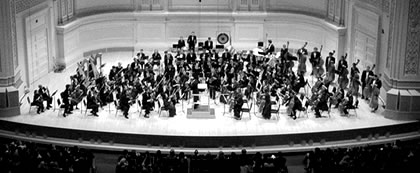
As the oboe’s ‘tuning A’ fades, the lights go down, a hush spreads across the audience, the conductor raises his baton, bringing it down with a flourish. So the orchestra starts, you settle back in your seat to listen, letting your mind drift away with the music.
Casting your eye across the faces of the musicians you begin to wonder if this is just another performance for them, just one more run-through of a well-rehearsed piece. Or is tonight special? Are they ready to invest the performance with something new, something magical that will send shivers down your spine?
As the music fills your mind, your eye is drawn to the conductor. His whole body is filled with meaning, vigorously communicating to his orchestra. The players themselves are focussed, as one, reacting precisely to this wildly gesticulating man. You start to get the feeling this is going to be good. A night to remember. If only it was always like this…
Leadership and group mood
In newly published research, Boerner and von Streit (2007) make progress towards this impossible end by suggesting two vital ingredients of the perfect performance. First they argue the orchestra’s individual players must be emotionally ‘in tune’ with each other. The finest quality of performance is not just about timing, it is about a harmony of mood.
The second vital component is the leadership style of the conductor. Recent research in psychology suggests that group success is inspired by people with ‘transformational’ leadership styles. Boerner and von Streit argue that transformational conductors are:
- Charismatic – the orchestra is proud to work with them.
- Inspirational – motivate the orchestra by making it clear what is required.
- Intellectually stimulating – often suggest new interpretations
Boerner and von Streit then surveyed 22 German orchestras for the conductor’s leadership style along with player’s mood as measured by the cohesiveness of the orchestra. Each orchestra was then independently rated on their overall level of artistic quality.
Conductor and orchestra interact
As the researchers expected, the highest quality orchestras were those with transformational conductors and high group mood. But the surprising result was the interaction that occurred between these two factors.
When the group mood of the orchestra was low, a transformational conductor was actually associated with a lower quality of orchestra. Similarly when the mood of the orchestra was high, a less transformational conductor was associated with a higher quality orchestra.
From this emerged the idea that orchestras with high group mood may actually ignore a poor conductor and still go on to produce a reasonable level of performance. According to Boerner and von Streit this is a well-known phenomenon in orchestras.
So the next time you go to the symphony, hoping to be transported, take a good look at the orchestra. Do they seem in a good mood? And when the conductor strides out, is it difficult for you, and the whole orchestra, to keep your eyes off him? If so, you could be in for a treat.
 References
References
Boerner, S., & von Streit, C. (2007). Promoting orchestral performance: the interplay between musicians’ mood and a conductor’s leadership style. Psychology of Music, 35(1), 132.

